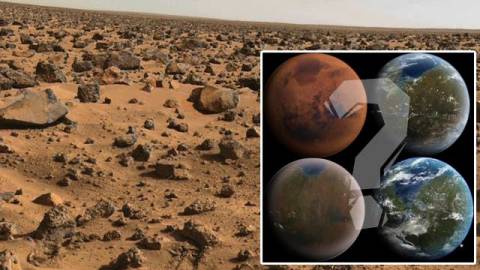Should We Use Comets and Asteroids to Terraform Mars?

First, I would like to thank all those who watched the Sci Fi Science debut and made it such a smashing success. I was overwhelmed by all the response. I did a web chat last week, and so many people logged on that the server crashed, so I would also like to apologize to those who might have been inconvenienced that day.
Second, I would like to comment about some of the questions that came pouring in after that episode. I certainly can’t possibly answer all the questions, but here are a few responses that I have chosen.
Question One:If you terraform Mars, making it into a Garden of Eden, won’t this be temporary, since Mars isn’t big enough to permanently hold onto an atmosphere.
Answer: You are absolutely correct. Mars is a small planet, and hence it’s gravitational field is not strong enough to permanently hold onto a dense atmosphere, but it is sufficient to hold onto an atmosphere for thousands to millions of years, which is enough for us. Once we terraform Mars, there will be enough of an atmosphere to take of all our needs for generations to come.
But it does mean that future generations, thousands of years from now, will have to replenish the atmosphere once again. For our purposes, however, it does not matter.
Question Two:Won’t sending comets and asteroids down on Mars cause lots of destruction to the surface?
Answer: In the program, we mentioned that it might be possible to heat up Mars using nuclear power plants, but this would be a very slow, expensive, and perhaps dangerous plan. A much faster plan would be to divert comets and meteors to Mars. We also mentioned that, if you aim the comet or meteor carefully, you can control its orbit. This means you can gently have the comet or meteor enter Mars orbit, and then slowly descend to the surface as the orbit decays. This means that much of the comet or meteor will burn up in the atmosphere and release water vapor. The point here is that we can accurately aim the comet or meteor so that we can minimize surface damage but maximize energy transfer, which is what we need to heat up Mars.
Question Three:What is the time frame for terraforming Mars?
Answer: Not anytime soon. A good guess is that we will have our astronauts on Mars by mid-century (given the set-backs in the current manned missions to space). So the first colonies will be established by later in the 21st century. Terraforming won’t begin until many decades after that. So we are talking about mid 22nd century before terraforming can be considered seriously. But as Carl Sagan was fond of pointing out, we should become a two planet species, since it is simply too dangerous to place the future of humanity on just one planet.
Next: How to Deflect Meteors and Comets





